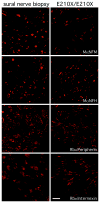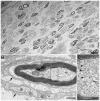A novel recessive Nefl mutation causes a severe, early-onset axonal neuropathy
- PMID: 20039262
- PMCID: PMC4439312
- DOI: 10.1002/ana.21728
A novel recessive Nefl mutation causes a severe, early-onset axonal neuropathy
Abstract
Objective: To report the first cases of a homozygous recessive mutation in NEFL, the gene that encodes the light subunit of neurofilaments.
Methods: Clinical and electrophysiologic data were evaluated, and a sural nerve biopsy from one affected child was examined by immunohistochemistry and electron microscopy. The ability of the mutant protein to form filaments was characterized in an established cell culture system.
Results: Four of five siblings developed of a severe, progressive neuropathy beginning in early childhood. Serial nerve conduction studies showed progressively reduced amplitudes with age and pronounced slowing at all ages. Visual-evoked responses were slowed in three children, indicating that central nervous system axons were subclinically involved. All four affected children were homozygous for a nonsense mutation at glutamate 210 (E210X) in the NEFL gene; both parents were heterozygous carriers. A sural nerve biopsy from an affected patient showed markedly reduced numbers of myelinated axons; the remaining myelinated axons were small and lacked intermediate filaments. The E210X mutant protein did not form an intermediate filament network and did not interfere with the filament formation by wild-type human light subunit of neurofilaments in SW-13 vim(-) cells.
Interpretation: This is the first demonstration of a recessive NEFL mutation, which appears to cause a simple loss of function, resulting in a severe, early-onset axonal neuropathy with unique features. These results confirm that neurofilaments are the main determinant of axonal caliber and conduction velocity, and demonstrate for the first time that neurofilaments are required for the maintenance of myelinated peripheral nervous system axons.
Figures







Comment in
-
NEFL-related Charcot-Marie-tooth disease: an unraveling story.Ann Neurol. 2009 Dec;66(6):714-6. doi: 10.1002/ana.21848. Ann Neurol. 2009. PMID: 20033987 No abstract available.
Similar articles
-
The novel neurofilament light (NEFL) mutation Glu397Lys is associated with a clinically and morphologically heterogeneous type of Charcot-Marie-Tooth neuropathy.Neuromuscul Disord. 2004 Feb;14(2):147-57. doi: 10.1016/j.nmd.2003.10.003. Neuromuscul Disord. 2004. PMID: 14733962
-
Myelinated axons fail to develop properly in a genetically authentic mouse model of Charcot-Marie-Tooth disease type 2E.Exp Neurol. 2018 Oct;308:13-25. doi: 10.1016/j.expneurol.2018.06.010. Epub 2018 Jun 22. Exp Neurol. 2018. PMID: 29940160
-
A novel homozygous nonsense mutation in NEFL causes autosomal recessive Charcot-Marie-Tooth disease.Neuromuscul Disord. 2018 Jan;28(1):44-47. doi: 10.1016/j.nmd.2017.09.018. Epub 2017 Oct 12. Neuromuscul Disord. 2018. PMID: 29191368
-
Childhood giant axonal neuropathy. Case report and review of the literature.J Neurol Sci. 1987 Dec;82(1-3):205-28. doi: 10.1016/0022-510x(87)90019-0. J Neurol Sci. 1987. PMID: 2831308 Review.
-
Giant axonal neuropathy. A review.Brain Dev. 1989;11(4):207-14. doi: 10.1016/s0387-7604(89)80038-5. Brain Dev. 1989. PMID: 2549797 Review.
Cited by
-
Absence of NEFL in patient-specific neurons in early-onset Charcot-Marie-Tooth neuropathy.Neurol Genet. 2018 Jun 5;4(3):e244. doi: 10.1212/NXG.0000000000000244. eCollection 2018 Jun. Neurol Genet. 2018. PMID: 29888333 Free PMC article.
-
From Cell Architecture to Mitochondrial Signaling: Role of Intermediate Filaments in Health, Aging, and Disease.Int J Mol Sci. 2025 Jan 27;26(3):1100. doi: 10.3390/ijms26031100. Int J Mol Sci. 2025. PMID: 39940869 Free PMC article. Review.
-
A review and analysis of the clinical literature on Charcot-Marie-Tooth disease caused by mutations in neurofilament protein L.Cytoskeleton (Hoboken). 2021 Mar;78(3):97-110. doi: 10.1002/cm.21676. Epub 2021 Jun 3. Cytoskeleton (Hoboken). 2021. PMID: 33993654 Free PMC article. Review.
-
Cerebrospinal Fluid Biomarkers of Alzheimer's Disease: Current Evidence and Future Perspectives.Brain Sci. 2021 Feb 10;11(2):215. doi: 10.3390/brainsci11020215. Brain Sci. 2021. PMID: 33578866 Free PMC article. Review.
-
Retinal Genomic Fabric Remodeling after Optic Nerve Injury.Genes (Basel). 2021 Mar 11;12(3):403. doi: 10.3390/genes12030403. Genes (Basel). 2021. PMID: 33799827 Free PMC article.
References
-
- Friede RL, Samorajski T. Axon caliber related to neurofilaments and microtubules in sciatic nerve fibers of rats and mice. Anat Rec. 1970;167:379–388. - PubMed
-
- Muma NA, Hoffman PN. Neurofilaments are intrinsic determinants of axonal caliber. Micron. 1993;24:677–683.
-
- Zhu Q, Couillard-Despres S, Julien JP. Delayed maturation of regenerating myelinated axons in mice lacking neurofilaments. Exp Neurol. 1997;148:299–316. - PubMed
-
- Jacomy H, Zhu QZ, Couillard-Despres S, et al. Disrupting of type IV intermediate filament network in mice lacking the neurofilament medium and heavy subunits. J Neurochem. 1999;73:972–984. - PubMed
Publication types
MeSH terms
Substances
Grants and funding
LinkOut - more resources
Full Text Sources
Other Literature Sources
Medical
Molecular Biology Databases
Miscellaneous

